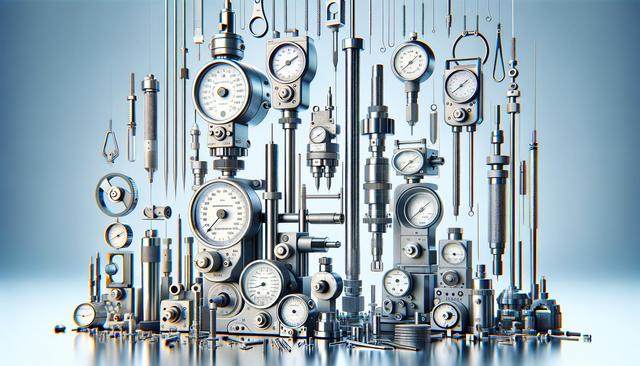Contact Extensometers
Contact extensometers are among the most commonly used types in material testing. These devices physically attach to the specimen being tested, usually via knife edges or clips, to measure deformation directly. Due to their simple mechanical design, they are often used in environments where cost-effectiveness and reliability are essential. Contact extensometers are particularly suitable for tensile and compression tests where high resolution and repeatability are required. Their direct contact with the specimen ensures consistent signal transmission, making them ideal for static testing scenarios. However, they may not be suitable for materials that are delicate or highly deformable, as the contact points can influence the material behavior. In such cases, alternative methods may be more appropriate.
Applications of contact extensometers include:
- Testing metals, plastics, and composites during tensile strength evaluations
- Determining elongation at break in quality control processes
- Measuring strain in structural elements for research purposes
Despite their widespread use, contact extensometers can be limited by factors such as wear and tear, calibration needs, and the potential for slippage during long-duration tests or high strain conditions.
Non-Contact Extensometers
Non-contact extensometers provide a solution for scenarios where physical attachment is impractical or may affect test results. These instruments use optical or laser-based systems to track strain and displacement without touching the specimen. This approach is highly beneficial for materials that are soft, brittle, or sensitive to surface damage. Non-contact extensometers are especially useful in high-temperature testing environments, where traditional contact methods might be compromised.
Advantages of non-contact extensometers include:
- Elimination of mechanical interference with the test sample
- High precision in measuring small or localized strains
- Capability to operate in extreme environmental conditions
These extensometers are often used in advanced research settings and for high-performance material testing, such as aerospace composites, polymers, and thin films. They also support dynamic testing applications due to their fast response times and high-resolution imaging capabilities.
Video and Laser Extensometers
Video and laser extensometers represent a sophisticated category of non-contact instruments. Video extensometers use high-speed cameras and software algorithms to analyze the displacement of marks or patterns on the material surface. Laser extensometers, on the other hand, use laser beams to detect changes in distance or geometry during deformation. Both systems offer precise measurements with minimal interference, making them suitable for dynamic and high-strain rate testing.
These extensometers are commonly used in:
- Fatigue testing of automotive and aerospace components
- Fracture mechanics studies
- Monitoring large deformations in elastomers and biological tissues
While these systems provide exceptional accuracy, they require careful setup and calibration. Environmental factors such as lighting, vibration, and surface reflectivity can influence their performance. Nevertheless, their versatility and non-intrusive nature make them valuable tools in cutting-edge material analysis.
Clip-On and Gauge Length Extensometers
Clip-on extensometers are a subset of contact types that attach directly to the specimen at precise gauge lengths. They are simple to use and widely adopted for standard tensile tests, especially when measuring elongation over a predefined length of material. These extensometers are often used in compliance with international testing standards, making them essential in regulatory and certification environments.
Typical applications include:
- Routine material verification in manufacturing
- Compliance testing for construction materials
- Determining modulus of elasticity and yield strength
Gauge length extensometers are favored for their ease of use and compatibility with various test frames. However, they may not be suitable for cyclic or high-speed tests where the mechanical attachment can introduce error or lag. Care must also be taken to ensure they are attached securely and aligned correctly for accurate measurements.
Applications Across Industries
The versatility of extensometers allows them to be used across a wide range of industries. In construction and civil engineering, they play a crucial role in evaluating the performance of concrete, steel, and composite reinforcements. In the automotive and aerospace sectors, extensometers contribute to the development of lighter, stronger materials by enabling precise stress-strain analysis. Academic and industrial laboratories rely on these instruments to validate theoretical models and conduct failure analysis.
Common industry applications include:
- Structural analysis for bridges, buildings, and other infrastructure
- Quality assurance in mass production of engineered components
- Research and development of new materials with enhanced mechanical properties
As material science continues to evolve, so does the need for accurate and adaptable measurement tools. Extensometers, with their range of configurations and capabilities, remain a cornerstone of mechanical testing, supporting innovation and reliability across sectors.
Conclusion
Extensometers are indispensable in modern material testing, offering accurate and reliable measurements of strain and deformation under various conditions. Choosing the right type—whether contact, non-contact, video-based, or clip-on—depends on the specific testing requirements and the nature of the materials involved. As industries demand more precise data to inform design and compliance, extensometers continue to be essential instruments in ensuring performance, safety, and quality across a broad spectrum of applications.




Leave a Reply